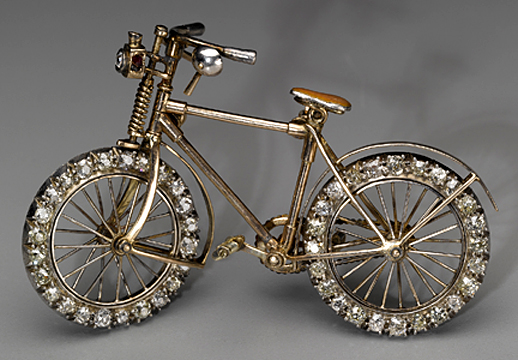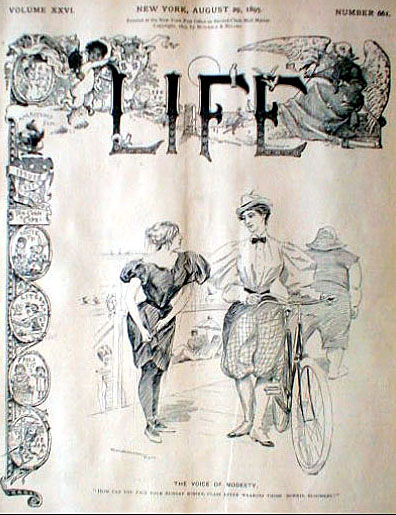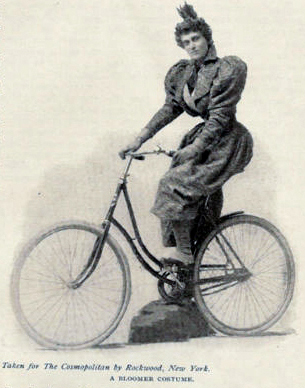
This jewel was created at the height of the bicycle craze that overtook Europe and the U.S. in the 1890s. It replicates the short-reach bicycles designed for women, with the mudguards and coiled brake part found on English bikes of the era. It has working gold wheels, pedals that rotate the chain and spin the rear wheel, an oil lamp set with a ruby, and a brown enamel seat made to look like leather.
You’ll find it at Jewels, Gems, and Treasures: Ancient to Modern opening July 19, the inaugural exhibit of the Boston Museum of Fine Arts’ new Kaplan jewelry gallery.
Like many pieces in the exhibit, the brooch is a time capsule – in this case, of a new-found freedom for women. Yet it’s amazing how little bicycles have changed in 115 years. Take off the diamonds and tweak a few details and you’d have your basic mountain bike.
Now imagine getting on that bike wearing a corset and floor-length skirt. That is precisely what most women did in the early days of the bicycle. But after countless spills and awkward adjustments, this new mode of transportation caused its own fashion revolution.
 Skirts got shorter and led to knickerbockers and bloomers. As Ida Trafford Bell wrote in Harper’s Bazaar back in the day: “The question of dress has become so serious and so divided a one that bicycling clubs and associations, as a general thing, have laid down no rules regarding dress, but allow each and every woman to use her own best judgment in clothing herself according to the laws of health, comfort and commonsense…”
Skirts got shorter and led to knickerbockers and bloomers. As Ida Trafford Bell wrote in Harper’s Bazaar back in the day: “The question of dress has become so serious and so divided a one that bicycling clubs and associations, as a general thing, have laid down no rules regarding dress, but allow each and every woman to use her own best judgment in clothing herself according to the laws of health, comfort and commonsense…”
 “Many, through custom and force of habit, prefer the conventional skirt, while others again object to it for the reason it requires a wheel some twelve to thirteen pounds heavier than that required for the bloomer or knickerbocker.”
“Many, through custom and force of habit, prefer the conventional skirt, while others again object to it for the reason it requires a wheel some twelve to thirteen pounds heavier than that required for the bloomer or knickerbocker.”

Cycling in a long skirt was something of an extreme sport. “When riding against the wind it expands into a balloon,” Bell wrote, “and by so doing offers great resistance to the rider, calling forth an unusual degree of physical exertion, and frequently compelling the rider to dismount from sheer exhaustion.”
I would imagine it was also a little embarrassing having your skirt blow up, exposing your bloomers to the world. This was a good 60 years before Marilyn Monroe caused a scandal doing that on a subway grate.
So what was the Victorian solution? Bloomers you could wear in public. “I think, of all the different costumes, the Turkish bloomer is the most popular, for the reasons that it answers every purpose and is less conspicuous,” Bell concluded, “for it can be worn where the knickerbocker or short drop skirt cannot without attracting to itself undue attention and criticism.”
For more on the history of women and bicycles, visit the Online Bicycle Museum.
Related posts:

